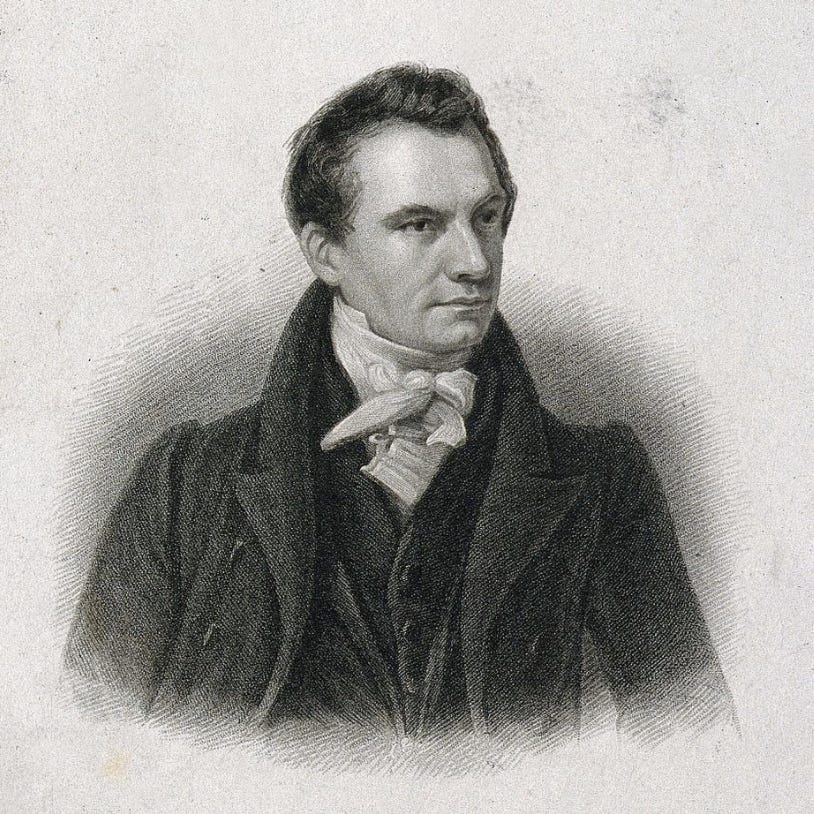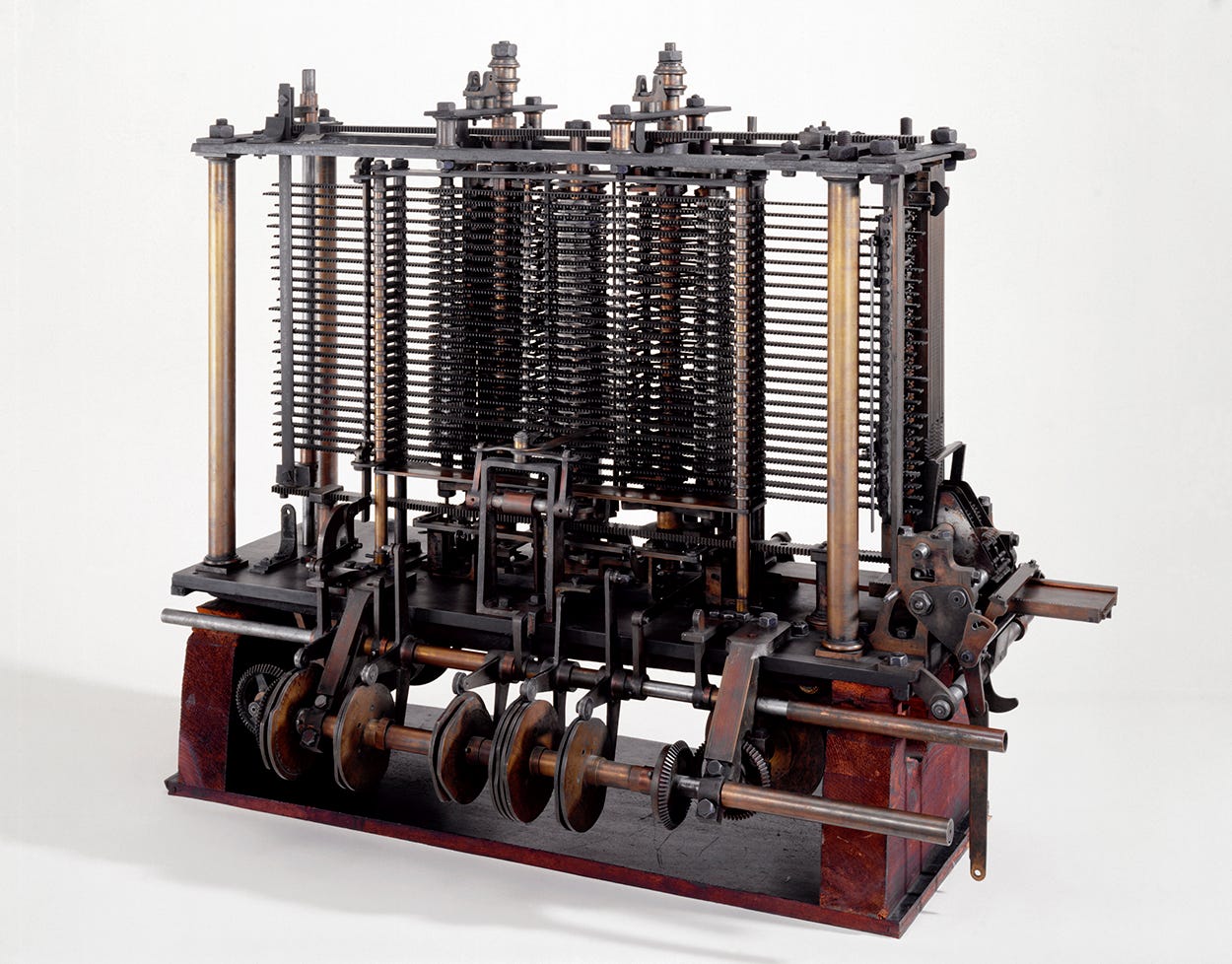Faraday and Babbage: Semiconductors And Computing in 1833
Two pioneers of key computing technologies were friends in 19th Century London
Hi everyone. This is very much a ‘one-off’ post as we’re heading back to 1833!
Discovering that Charles Babbage and Michael Faraday, very early pioneers of computer architecture and the properties of semiconductors respectively, knew each other, was too good not to write about. Normal service will be resumed next time in the second half of the twentieth century!
In London in 1833, two men independently made breakthroughs in what would develop into the two technologies that underpin modern computers; semiconductors and computer architecture.
The two men would surely be both astonished and delighted at the importance of these technologies in the 21st century.
Each technology would develop separately for one hundred and twenty years before reuniting in 1953 in the form of the first transistorised computer. Today, these technologies underpin the development of almost all modern computers.
The two men were Michael Faraday and Charles Babbage. Although very different personalities, they were friends, active at the Royal Institution in London and they occasionally collaborated on their research.
Neither could have have known that their work in 1833 would combine and develop into the most important and transformational technology of the late 20th and early 21st centuries.
Michael Faraday (1791-1867) is best known for his work on electromagnetism and his discovery of the principles of electromagnetic induction. He would use his discoveries to develop the dynamo, which would become the basis for the electric motor and, until recently, for almost all electrical power generation.
In 1833 Faraday was first to observe and record one of the properties of semiconductors in action 1:
“I have lately met with an extraordinary case … On applying a lamp under the sulphuret between the poles, the conducting power rose rapidly with the heat … and the sulphuret was found conducting in the manner of a metal.”
Michael Faraday, Experimental Researches in Electricity (1838).
Sulphuret, or Silver Sulphide, is a grey powder, which appears as the tarnish on silverware. Faraday observed that, unlike metals, sulphuret conducted electricity more easily when hot than when cold. Silver Sulphide is a semiconductor and Faraday had seen, for the first time, one of the properties of semiconductors.
Faraday’s interests were wide-ranging. In addition to his work in electromagnetism and electricity, he also worked on chemistry, including discovering Benzene.
Born into a relatively poor family he received little formal education and had a limited knowledge of mathematics when compared to his peers. Despite this, by 1813 he was employed at the Royal Institution in London, working for the chemist Humphrey Davy. Faraday gained Davy’s attention by sending him a 300 page book of notes taken at Davy’s lectures.
Charles Babbage (1791-1871) came from a very different background. His family were relatively well off, and in 1810 he started to study Mathematics at Trinity College, Cambridge. In 1829 became Lucasian professor of Mathematics in the University of Cambridge, the chair held previously by Newton and later by Hawking.
Babbage is best known today for his work on the ‘Difference Engine’ and the ‘Analytical Engine’. Work on the Difference Engine, a mechanical device designed to compute values of polynomial functions started in the 1820s but by 1833, with funds running out, it had ground to a halt.
Although not documented until 1834, it seems likely that it was in 1833 that he started work in earnest on his next project, the more ambitious Analytical Engine.
The designs for the Analytical Engine represent the first outline for the design of what would be called today a ‘stored program computer’. Babbage never built a working version of the Analytical Engine as he again ran out of money and struggled to find support for his project.
Babbage was a true polymath. His wide ranging interests extended to include research into chemistry, mechanical engineering, electromagnetism and even economics.
So despite their very different backgrounds and skills, the two men had much in common. Both lectured and the Royal Institution and became Fellows of the Royal Society. In fact, Babbage was one of those who proposed Faraday for Fellowship. Babbage even consulted Faraday on several occasions on the subject of analytical chemistry.
Babbage sent Faraday a copy of the Menabrea paper, a translation of a description of the Analytical Engine by Italian mathematician Luigi Menabrea. Faraday, acknowledging receipt, commented that ‘… though I cannot understand your great work yet I can well comprehend by its effect upon those who understand how great a work it is ...’
The two men developed a closer friendship as the years passed. Their correspondence became increasingly familiar, changing from the formal ‘Dear Sir’ to ‘Dear Babbage’ or ‘Dear Faraday’ to ‘Ever yours truly’.
They had a common acquaintance in Ada, Countess of Lovelace, Babbage’s longtime collaborator and supporter. The correspondence between Faraday and Lady Lovelace includes her wish to promote Faraday’s ‘experimental researches in electricity’ just as she had supported Babbage’s ‘engines’.
Despite their friendship, the two men’s characters were quite different. Faraday was an eloquent teacher and soon became famous as a lecturer at the Royal Institution. Babbage, on the other hand, was known for his abrasive personality and became frustrated at the lack of recognition for his work.
The two men’s ideas of 1833 later developed in very different ways. Faraday was not able to progress his discovery, but over time others took up the challenge and steadily the understanding and use of semiconductors increased.
More materials became identified as semiconductors, including those based on Silicon and Germanium. New uses were found for them too, notably as the basis for rectifiers to detect radio signals.
In 1947 Shockley, Bardeen and Brattain constructed the first transistor at Bell Labs; an invention that would win them the Nobel prize and set the stage for the wider adoption of semiconductors.
In contrast, Babbage’s ideas remained largely untouched for over a century. The work to develop electronic stored program computers at the end of the Second World War and soon afterwards2, finally made them a practical and commercial reality. These first computers used vacuum tubes, but transistors offered an alternative that was smaller, more reliable and less power-hungry.
The first computer to use transistors was the Manchester Transistor Computer which used 92 Germanium point-contact transistors and 550 diodes and was first operational in November 1953. The Manchester Transistor Computer still used some valves; the first all-transistor computer, TRADIC (for TRAnsistor DIgital Computer) was built at Bell Labs and became operational in 1954.
Neither Faraday or Babbage could have had any idea that Faraday’s observation would be a step on the development of a technology that would turn Babbage’s concept into its modern reality.
The two men would surely be both astonished and delighted at the importance of these technologies in the 21st century.
Image Credits
Analytical Engine
CC BY-SA 2.0
via Wikimedia Commons
Thomas Johann Seebeck (1770-1831) is thought to be the first to notice properties of semiconductors when in the 1820s he observed some of the magnetic effects of semiconductors whilst working in Berlin.
Konrad Zuse (1910-1995) built an electromechanical computer, the Z3 which was completed in 1941 and was the first programmable, automatic, digital computer.







